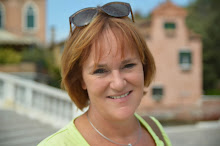- white drawing sheet A4 size
- watercolour paint
- tempera paint
- indian ink
- q-tips
- straws
- black construction paper
woensdag 25 november 2009
Blowing trees
maandag 23 november 2009
Wrapped art, like Christo
Wrapping like Christo
Ask students to take an object from home that:
- is larger than a soda can;
- fits on a table;
- is not breakable;
- is not expensive;
- may stay in school for some days;
- has a particular form (not just a box)
Discuss with the children why people wrap things: to protect, to surprise (presents), to ship. Why has Christo wrapped things? What is the effect of the wrapped objects? Look at some Christo projects and discuss them.
A wrapped easel
You need:
- an object for each kid
- big fabrics, pieces of plastic, garbage bags, wrapping papier, toilet paper, aluminum foil and plastic wrap
- materials to tie, like rope, yarn, tape, wire, fishing line, painter tape and fabric strips
- materials to decorate, like feathers, paint, markers, coloured paper, textile markers, glitter glue, buttons etc.
A wrapped Christmas decoration
Lesson and photo's received from Linda Vroemisse
zondag 22 november 2009
Dutch December skyline
You need:
- construction paper A4 size in dark blue, yellow and black
- paperclips
- scissors
- knives
- cutting blade
- glue
Draw the skyline of a street on the black paper. Add a tree if you want to, or draw a black pete near the chimney.
Put the black sheet on the yellow one and attach them to each other with four paperclips. Cut out the skyline; you'll cut two sheets at the same time. When ready, remove the paperclips and cut some windows out of the black sheet.
Cut a moon out of the rest of the yellow sheet. Stick the black and yellow skyline together and shift the black sheet one millimeter to emerge the yellow one. Look carefully to the position of the moon: you'll see the yellow edges there were the moon shines. Glue the moon on the blue sheet and glue the skyline below. Your December skyline is finished!
dinsdag 10 november 2009
Explosion at the bottle factory
- black construction paper
- scissors and glue
- coloured paper
- ruler and pencil
maandag 9 november 2009
The longest line
- white drawing sheet 15 by 15 cm
- black fineliner
- markers
I found this lesson on Artsonia. Start in a corner and draw ONE line, the longest line: curved, straight, zigzag, with angles etc. The line has to fill the whole sheet and you may not pick up your marker from the sheet! The line may not hit or cross itself. And, the most important: the line has to end at the point it started. So be sure you're back in the beginning in time!
When ready, draw with a pencil three or four geometric shapes on your sheet. Choose three colours marker per shape and colour them. Outline your shapes with the black fineliner.
dinsdag 3 november 2009
Greetings from ... Holland!
- white drawing sheet from 20 by 10 cm
- markers
- fineliner
- ruler
- pencil
zondag 1 november 2009
Find it!
- white drawing paper A4 size
- watercolour paint or tempera
- marker or fineliner
Tempera with marker



















